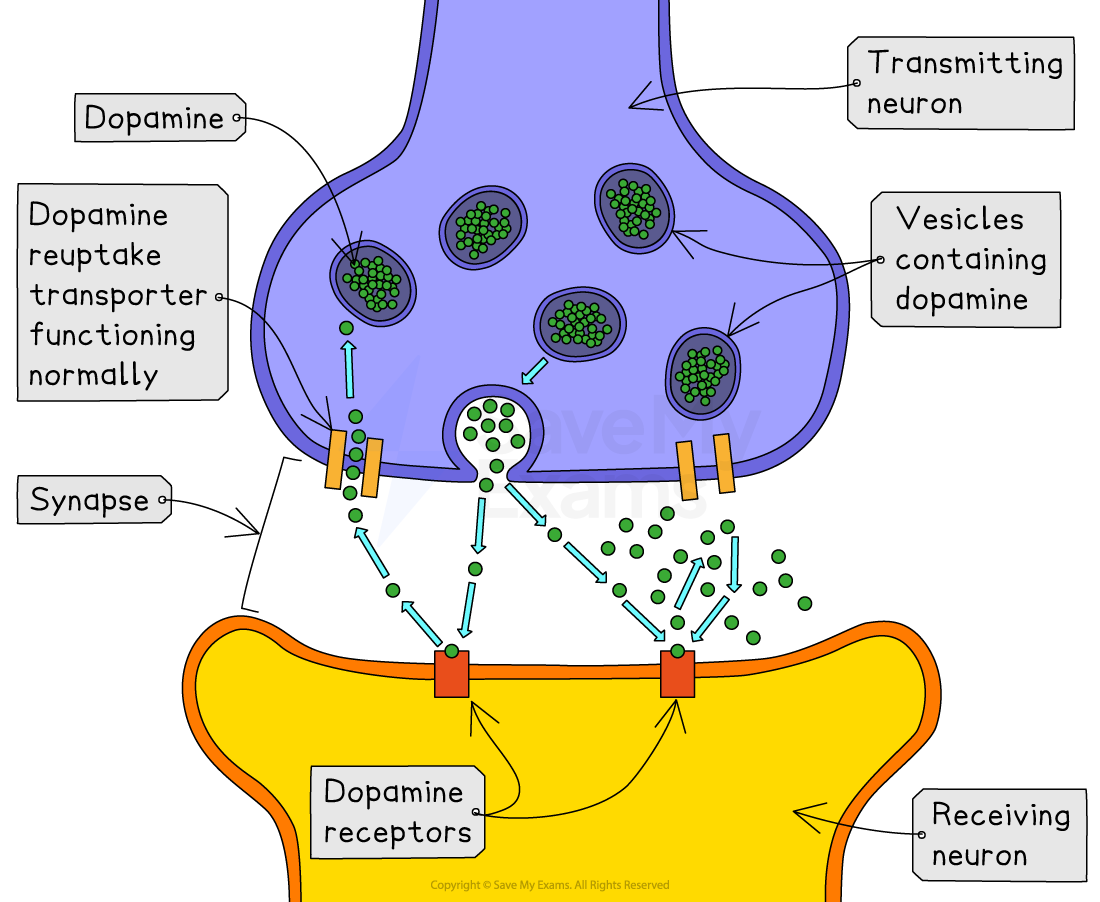Biological Explanation of Schizophrenia (OCR GCSE Psychology): Revision Note
Exam code: J203
The dopamine hypothesis
The dopamine hypothesis is a biological explanation of schizophrenia
It assumes the disorder has a biological basis due to abnormalities in:
brain structure
brain function
neurotransmitter activity
These abnormalities may result from genetic vulnerability, making some individuals more likely to develop schizophrenia
Key ideas
Schizophrenia is linked to overactivity in the dopamine system
Dopamine is a neurotransmitter involved in movement, attention, emotion, and perception
Dopaminergic neurons transmit dopamine across synapses (gaps between neurons)
In schizophrenia:
these neurons fire too often or too easily, causing excess dopamine release
dopamine receptors (particularly D2 receptors) become overstimulated
brain messages become confused or exaggerated
As a result, this can lead to:
hallucinations – hearing or seeing things that aren’t there
delusions – false beliefs or paranoia
disorganised thinking and speech
Research shows that people with schizophrenia tend to have more dopamine receptors in certain brain areas
This leads to more frequent neuron firing supporting the link between dopamine imbalance and positive symptoms of schizophrenia

Brain structure & function
Brain scans show that the brains of people with schizophrenia often look different from those without the disorder
Abnormalities in brain structure and function are linked to symptoms and behaviours
Frontal lobes
The frontal cortex acts as the brain’s 'control centre', responsible for:
planning
decision-making
self-regulation
People with schizophrenia show:
reduced blood flow and lower activity in the frontal cortex
impaired judgement and disorganised thinking
a smaller or less active prefrontal cortex, leading to poor logical and goal-directed behaviour
Temporal lobes
The temporal lobes are involved in processing auditory information and understanding speech
In schizophrenia studies show:
reduced volume in these areas
symptoms such as auditory hallucinations, where individuals hear voices that are not real
Hippocampus
The hippocampus, which helps form new memories and regulates emotion
In schizophrenia, research shows:
a smaller hippocampus
the more severe the symptoms, the greater the hippocampal shrinkage
This is associated with:
memory problems
emotional instability
difficulty distinguishing between reality and imagination
Neurological damage
Some researchers believe that neurological damage may occur before birth, when the brain is still developing
Infections, lack of oxygen, or complications during pregnancy or birth can damage brain cells and affect normal brain development
This early damage increases a person’s vulnerability to schizophrenia later in life
The effects may not appear until adolescence or early adulthood, when the affected brain areas become fully active
Criticisms of the biological explanation
Ignores the role of nurture
The theory focuses mainly on biological causes (nature) and neglects environmental or psychological factors such as stress, trauma, or family conflict (nurture)
Schizophrenia may result from an interaction between biology and environment, not biology alone
Cause and effect problem
Brain dysfunction might be a result of schizophrenia rather than the cause
Many studies rely on post-mortems or brain scans after diagnosis, so it’s unclear whether brain changes existed beforehand
Deterministic
The theory implies that people have no control over their symptoms, as behaviour is seen as entirely caused by brain activity
This view is pessimistic and ignores personal responsibility or free will
Reductionist
It oversimplifies a complex disorder by reducing it to brain chemicals or structure alone
Psychological and social factors likely interact with biology to produce symptoms
'Schizophrenia’ as too broad a label
Some psychologists argue that schizophrenia covers a wide range of symptoms
It may be unrealistic to look for one single biological cause for such a varied disorder

Unlock more, it's free!
Did this page help you?